Nymphs
{{start}}
The word nymph has of course two fly fishing meanings. The first is “Juvenile, sexually immature stage of certain insects, usually similar to the adult in form, and which require an intermediate stage before becoming an adult. Mayflies, Caddis flies, Dragonflies, Damselflies, Stone flies and Midges are all insects that spend part of their life cycle in the water and have a nymph stage.” The second which is flies tied to the first i.e. “the nymphal stage of an insects life cycle.I have narrowed down the selection of nymphs that I carry to the list below’.
{{end}}
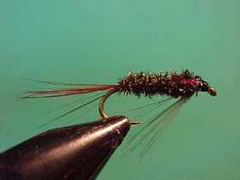
{{+1}}Diawl bach{{-1}}
{{start}}
I normally fish smaller sizes as a midge pupa and from time to time use larger sizes as a point fly in a team of wet flies on a floating or intermediate line. I tie it both with and without weight and find the addition of a small black tungsten bead makes it a handy anchor fly or a good prospecting fly in running water.{{end}}
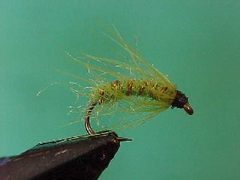
{{+1}}Fuzzy spiders – Chatto’s original{{-1}}
{{start}}
There is almost no limit to the combinations that you can come up with and these are the ones that I regularly fish and you may like to try. I don't know if fish pick them up as emerging insects but they do fish well when fish have emergers on the menu.{{end}}
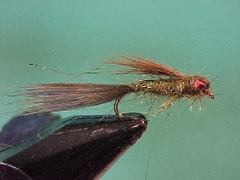
{{+1}}Damsel – Chatto’s MK1{{-1}}
{{start}}
There are over 100 different species of Damselflies in Australia and the lava which are usually slender with three terminal gills, that present as tails, form a significant part of a trout's diet. Their bodies have around 10 segments, they have 6 legs and they often have emerging wings. Most appear to be shades of yellow / olive and brown / yellow with some being quite dark and others quite pale.{{end}}

{{+1}}Kalkite special{{-1}}
{{start}}
This fly has stood the test of time and has been on this web site since 2005. Over the last 10 or so years it has been my 'go to' fly when fishing to sighted fish or prospecting the shores of Lake Jindabyne particularly around our home village of Kalkite.{{end}}
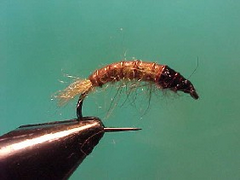
{{+1}}Foetal caddis grub{{-1}}
{{start}}
My preferred colours are light brown, light olive and hares ear each with slightly darker thoraxes and sand with a touch of orange or pink. All are tied with olive backs and heavily weighted so that they get down to where the fish are sitting.{{end}}
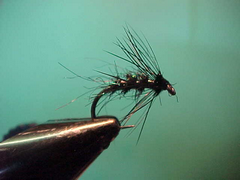
{{+1}}Dark magic – Chatto original{{-1}}
{{start}}
As long as there is a flow in a river to work a fly then English Spiders are an option. Particularly if you want to target educated fish in clear slower water. They land softly and are suggestive little flies. The combination of the buggy shape, the movement of the soft hackle often produce a hit.{{end}}
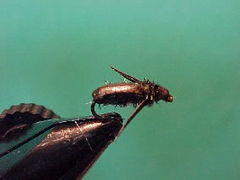
{{+1}}Corixia / back swimmer{{-1}}
{{start}}
Given the similarity of form and function both of these aquatic bugs can be represented by the following fly. This fly is best fished on a floating line that has been greased to within a meter of the fly or under a dry fly. It generally works well just sinking in the water column or moving naturally with the water current. If unnoticed try a couple of short figure of eight strips punctuated by a long pause to represent the natural swimming action of both bugs or a gentle lift to mimic "the natural" rising to the surface to breath.{{end}}

{{+1}}English spiders{{-1}}
{{start}}
As long as there is a flow in a river to work a fly then English Spiders are an option. Particularly if you want to target educated fish in clear slower water. They land softly and are suggestive little flies. The combination of the buggy shape, the movement of the soft hackle often produce a hit.{{end}}
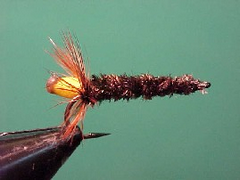
{{+1}}Stick caddis – Chatto’s tie{{-1}}
{{start}}
This is the lava of a Caddis fly (or Sedge) and is common from September through to December particularly in the flooded margins of lakes. Can be fished relatively static as a prospecting fly with a very slow retrieve or used as an ambush fly when polaroiding.{{end}}
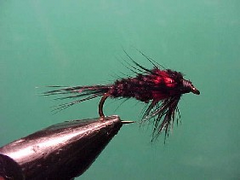
{{+1}}Montana nymph{{-1}}
{{start}}
The Montana nymph was developed in the earlier days of fly fishing in Montana America as an imitation for a stonefly. It has two distinct uses. The first is as a bait fly when fished behind a bead head nymph in faster rivers and streams. The second use is as as a middle dropper fly in a team of lock style flies in still water where the the flash of red, yellow, orange or pink in the thorax it make it a great attractor pattern.{{end}}













